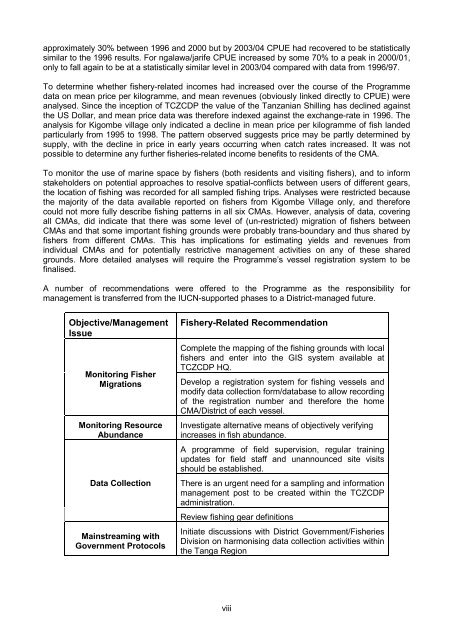Create successful ePaper yourself
Turn your PDF publications into a flip-book with our unique Google optimized e-Paper software.
approximately 30% between 1996 and 2000 but by 2003/04 CPUE had recovered to be statistically<br />
similar to the 1996 results. For ngalawa/jarife CPUE increased by some 70% to a peak in 2000/01,<br />
only to fall again to be at a statistically similar level in 2003/04 compared with data from 1996/97.<br />
To determine whether fishery-related incomes had increased over the course of the Programme<br />
data on mean price per kilogramme, and mean revenues (obviously linked directly to CPUE) were<br />
analysed. Since the inception of TCZCDP the value of the Tanzanian Shilling has declined against<br />
the US Dollar, and mean price data was therefore indexed against the exchange-rate in 1996. The<br />
analysis for Kigombe village only indicated a decline in mean price per kilogramme of fish landed<br />
particularly from 1995 to 1998. The pattern observed suggests price may be partly determined by<br />
supply, with the decline in price in early years occurring when catch rates increased. It was not<br />
possible to determine any further fisheries-related income benefits to residents of the CMA.<br />
To monitor the use of marine space by fishers (both residents and visiting fishers), and to inform<br />
stakeholders on potential approaches to resolve spatial-conflicts between users of different gears,<br />
the location of fishing was recorded for all sampled fishing trips. Analyses were restricted because<br />
the majority of the data available reported on fishers from Kigombe Village only, and therefore<br />
could not more fully describe fishing patterns in all six CMAs. However, analysis of data, covering<br />
all CMAs, did indicate that there was some level of (un-restricted) migration of fishers between<br />
CMAs and that some important fishing grounds were probably trans-boundary and thus shared by<br />
fishers from different CMAs. This has implications for estimating yields and revenues from<br />
individual CMAs and for potentially restrictive management activities on any of these shared<br />
grounds. More detailed analyses will require the Programme’s vessel registration system to be<br />
finalised.<br />
A number of recommendations were offered to the Programme as the responsibility for<br />
management is transferred from the <strong>IUCN</strong>-supported phases to a District-managed future.<br />
Objective/Management<br />
Issue<br />
Monitoring Fisher<br />
Migrations<br />
Monitoring Resource<br />
Abundance<br />
Data Collection<br />
Mainstreaming with<br />
Government Protocols<br />
Fishery-Related Recommendation<br />
Complete the mapping of the fishing grounds with local<br />
fishers and enter into the GIS system available at<br />
TCZCDP HQ.<br />
Develop a registration system for fishing vessels and<br />
modify data collection form/database to allow recording<br />
of the registration number and therefore the home<br />
CMA/District of each vessel.<br />
Investigate alternative means of objectively verifying<br />
increases in fish abundance.<br />
A programme of field supervision, regular training<br />
updates for field staff and unannounced site visits<br />
should be established.<br />
There is an urgent need for a sampling and information<br />
management post to be created within the TCZCDP<br />
administration.<br />
Review fishing gear definitions<br />
Initiate discussions with District Government/<strong>Fisheries</strong><br />
Division on harmonising data collection activities within<br />
the <strong>Tanga</strong> Region<br />
viii
















